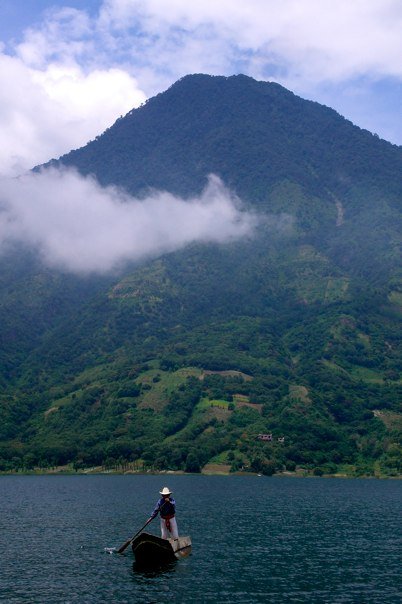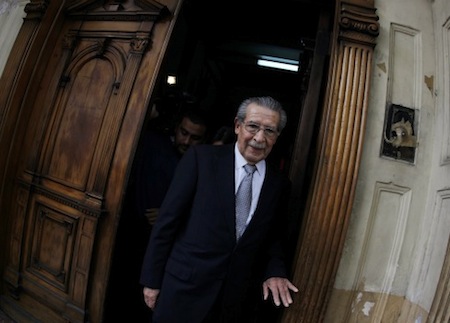Central America was a rough neighborhood during the Cold War.![]()
And Guatemala, with a civil war that essentially began with the overthrow of elected president Jacobo Árbenz Guzmán (with U.S. support) in 1954, and ended only with a peace treaty in 1996, was particularly rough.
Even in that context, however, the reign of Efraín Ríos Montt in the early 1980s, again backed by the United States, was a particularly brutal one.
Ríos Montt, however, this week became the first ever head of state to be tried for genocide in the Western Hemisphere, when a Guatemalan judge ruled that the trial will go forward — authorities charged Ríos Montt in early 2012 with genocide and crimes against humanity for, particularly, 1,771 deaths of indigenous Ixil Mayans during his 17-month reign, but really over 10,000 deaths in 1982 attributed to Ríos Montt’s regime — it’s a trial that could bring about a greater awareness of the atrocities committed not only in Guatemala, but throughout Central America during the Cold War, as well as the complicity of the United States in some of the most brutal events in Latin American history in the 20th century.
Ríos Montt, now aged 86, continues to argue for amnesty under the basis of a 1996 amnesty, but his lawyers have been accused of using legal tactics to bring about additional delays in the case.
Under international law, crimes against humanity and genocide have been considered to be exempt from national amnesty statutes, and indeed, even under Guatemala’s 1996 national conciliation law, genocide, torture and forced disappearances are expressly exempt from amnesty.
Today, the misty mountain air of Lake Atitlán in the Guatemalan highlands is best known for tourism rather than terror (pictured above). Towns like Huehuetenango and Santiago Atitlán, in 2013, are better known as a source of fair-trade coffee than as a site of genocide.
But 30 years ago, the Guatemalan highlands saw some of the worst atrocities of the Guatemalan civil war.
Ríos Montt, like many Guatemalan leaders of the period, came to power from an army coup in March 1982 after a round of particularly fraudulent elections, and Guatemala, then locked into its third decade of civil war between Marxist rebels and the army-backed state, was certainly not new to atrocities.
But what followed in the 17 months of Ríos Montt’s reign, as recounted and recorded in at least two truth and reconciliation commissions in subsequent years, outpaced what had come before, especially with regard to an indigenous population caught in the crosshairs in the showdown between army and rebel forces.
Spearheading a campaign referred to as ‘frijoles y fusiles’ (beans and guns), the message from Ríos Montt was clear: support us and we’ll feed you; otherwise, we’ll kill you. The military, allegedly under orders from Ríos Montt, engaged a scorched-earth campaign against the indigenous highlanders, destroying hundreds of Mayan villages, killing tens of thousands, and displacing hundreds of thousands more.
Ríos Montt, who had become (predictably) unpopular in his 17-month reign, was subsequently deposed by his defense minister, Óscar Humberto Mejía, in August 1983. Mejía, who has also been accused of orchestrating atrocities as well, if not at quite the same scale as during the Ríos Montt era, stepped down in 1986 with the election of Vinicio Cerezo. Although the final Guatemalan ceasefire wouldn’t come for another decade, the 1986 election was a turning point toward peace and the normalization of Guatemalan life.
Ríos Montt, however, remained a force in Guatemalan politics as the leader of the right-wing Frente Republicano Guatemalteco (FRG, Guatemalan Republican Front) — although he was barred from running in the 1999 presidential election, allies on the Guatemalan Constitutional Court cleared his 2003 presidential run, and his spirited campaign netted him third place with around 19% of the vote — ironically, much of the FRG’s right-wing support came disproportionately from the highlands that were the site of so many of the crimes Ríos Montt is now charged.
But the FRG’s power has slipped since its high-water mark in 1999, when Ríos Montt’s ally Alfonso Portillo (now awaiting trial himself in the United States for money laundering) won the presidency, and the FRG slipped to just one seat in the 158-member unicameral Guatemalan Congress after the most recent 2011 parliamentary elections.
After those elections, when Ríos Montt (pictured below) lost his seat in the Guatemalan Congress, he also lost his prosecutorial immunity, opening the path to this week’s events.
Guatemala’s president since January 2012, Otto Pérez Molina, was a general in the Guatemalan army in the 1980s, and served in the highlands during the Ríos Montt era, though he ultimately backed Mejía’s coup to remove Ríos Montt from power. Like Ríos Montt, he trained at the notorious U.S.-organized School of the Americas, and he also served in the special forces and as director of military intelligence.
Currently, Pérez Molina is most well-known for advocating a new approach to the U.S. war on drugs, notably through decriminalization, a campaign that he’s most recently been waging at the World Economic Forum in Davos.
But with the Ríos Montt trial now certain to move forward, Molina will also surely face additional scrutiny for his own role during the early 1980s.
The two issues are intertwined — Claudia Paz y Paz, Guatemala’s attorney general since 2010, has aggressively targeted both the perpetrators of war crimes from the 1980s as well as current drug kingpins. Despite her appointment in the previous administration, Pérez Molina has pledged that Paz y Paz will continue to serve her term through 2014, notwithstanding the more leftist tilt of the prior administration of Álvaro Colom.
Furthermore, Pérez Molina came to office with a desire to end a U.S.-imposed ban on military aid to Guatemala, instated in 1978 by the administration of U.S. president Jimmy Carter (even before the Ríos Montt-led atrocities),
During his tenure, Ríos Montt found plenty of support, however, from the administration of Carter’s successor as U.S. president, Ronald Reagan. The Reagan administration found in Ríos Montt a staunch anticommunist leader fighting a war against Marxist, pro-Soviet rebels, so U.S. support was only natural, though top born-again evangelicals in the United States, in particular, such as Pat Robertson and Jerry Falwell, who fueled the rise of the religious right in the 1980s in U.S. politics, vigorously supported Ríos Montt, himself a born-again Pentecostal in a country that is today where a 50% to 60% majority are Catholic.
U.S. president Bill Clinton formally apologized in 1999 for the role that the United States played in the atrocities against Mayans during the Guatemalan civil war, though the destabilizing role that the U.S. played in Guatemala, in the early 20th century, in the 1954 overthrow of Árbenz and during the massacres of indigenous populations in the early 1980s is not nearly as well-known generally as the U.S. roles in Nicaragua and in Panamá in the 1980s and 1990s.
Top photo credit to Kevin Lees — Lake Atitlán, September 2009. Bottom photo credit to Jorge Lopez/Reuters.


One thought on “Former Guatemalan dictator Ríos Montt to be tried for genocide”